- Преподавателю
- Иностранные языки
- Конспект открытого урока по теме: «Different Holidays» 8 класс
Конспект открытого урока по теме: «Different Holidays» 8 класс
| Раздел | Иностранные языки |
| Класс | 8 класс |
| Тип | Конспекты |
| Автор | ТАРХАНОВА О.В. |
| Дата | 22.02.2016 |
| Формат | doc |
| Изображения | Есть |
Состав работы:
Учитель:
Тарханова Ольга Викторовна
Образовательное
учреждение:
Муниципальное бюджетное общеобразовательное учреждение средняя общеобразовательная школа № 29
Предмет:
Английский язык
Краткая аннотация
урока:
вниманию предлагается план-конспект урока английского языка на тему «Различные праздники» по учебнику «Английский язык 8 класс» В.П. Кузовлева с использованием проектора и экрана. Учебно-методическими задачами урока являются: формирование лексических навыков говорения, практиковать учащихся в монологической речи, расширение лингвистического и общего кругозора школьников; развитие коммуникативных навыков. На уроке используются различные формы классной работы: фронтальная, групповая, индивидуальная. Использование ИКТ на уроке ориентирует учеников на результативность и успех.
Класс, профиль:
8 класс,
Тема раздела:
Традиции и обычаи Великобритании
Тема урока:
Различные праздники
Тип урока:
Комбинированный
Цели урока:
Обобщение и закрепление лексико-грамматических навыков по теме «Праздники», развитие умений монологической речи на основе предложенной ситуации, контроль приобретенных навыков и умений.
Задачи урока:
образовательная - формирование лексических навыков говорения, практиковать учащихся в монологической речи, расширение лингвистического и общего кругозора школьников;
воспитательная - создание условий для формирования у учащихся уважения к народам стран изучаемого языка; создание условий для воспитания культуры общения и поддержания интереса к учению;
развивающая - развитие языковых, познавательных способностей учащихся, развитие внимания, памяти, развитие эмоций школьников и готовности к коммуникации, гуманистическое развитие личности ученика.
Формируемые
умения и
навыки:
развитие речевых умений и навыков учащихся
Цели
использования
ИКТ
Целью использования ИКТ на уроке является повышение мотивации учащихся к изучению английского языка и обеспечение их активности на уроке.
Этап урока, на
котором использовались
ИКТ
Речевая разминка, закрепление материала
Формы организации работы детей
Фронтальная, индивидуальная, групповая.
Формы организации работы учителя
Фронтальная форма, контроль
Технологические особенности
На уроке использовать информационно-коммуникативные технологии, игровые технологии.
Технические условия
Урок проводится в кабинете, где есть компьютер, проектор, экран.
Используемое оборудование:
Магнитофон, компьютер, проектор, экран.
Перечень
разработанных цифровых образовательных ресурсов
Презентация № 1, презентация № 2, презентация № 3
Перечень внешних цифровых образовательных ресурсов
learnenglish.de/britishculture
abc-english-grammar.com/1/top133.htm
Конспект открытого урока
по теме: «Different Holidays»
8 класс
Цель: Обобщение и закрепление лексико-грамматических навыков по теме «Праздники», развитие умений монологической речи на основе предложенной ситуации, контроль приобретенных навыков и умений.
Задачи: образовательная - формирование лексических навыков говорения, практиковать учащихся в монологической речи, расширение лингвистического и общего кругозора школьников;
воспитательная - создание условий для формирования у учащихся уважения к народам стран изучаемого языка; создание условий для воспитания культуры общения и поддержания интереса к учению;
развивающая - развитие языковых, познавательных способностей учащихся, развитие внимания, памяти, развитие эмоций школьников и готовности к коммуникации, гуманистическое развитие личности ученика.
Тип урока: комбинированный
Оборудование: наглядности, компьютер, проектор, экран, магнитофон и кассета.
Методы: словесный, коммуникативный, наглядно-визуальный, практический, игровой, закрепление, повторение, самостоятельная работа учащихся, контроль, репродуктивно-продуктивный метод, имитация.
ХОД УРОКА
Этапы урока
Речь учителя
Речь учащихся
Запись на доске
Оснащение
1.Организа-ционный момент.
2.Речевая разминка.
3.Закреп-ление материала с использова-нием видео, презентаций
и игрового метода.
4. Заключи-
тельный этап и подведение итогов.
Good afternoon boys and girls, good afternoon everybody in this classroom. Today we have a total lesson on the topic which is called "Holidays". We'll remember some holidays, their symbols and some traditions. I hope you'll be very industrious and active.
Look at the black board and read the epigraph. These words will be the main idea of our lesson.
But today our lesson is unusual. We need two teams for a competition. So we start our lesson with worming up and remember some holidays.
Look at the board me. You can see a magic flower. On it's petals there are questions. So, please, choose one of the petals read and answer the questions.
Now, each of you has a petal of red or yellow colour. Pupils with red petal go to the desk with rose and pupils with yellow at the table with pumpkin. So the first team is called roses and the second team is called pumpkins.
Let's greet our jury.
Start a game.
Contest 1: "Pantomima"
You watch one scene, then think for some minutes and retell the story aloud.
So, the word for our jury.
Contest 2: Listen to some expressions and guess what holiday is spoken about. For each right answer the team gets a counter. (учащиеся читают высказывание данное на доске и поднимают карточку с правильным ответом)
1. The main symbol of this holiday is heart.
2. The symbols of this holiday are rabbit and decorated eggs.
3. This day is for lovers.
4. The symbols of this holiday are the fur-tree and Father the Frost.
5. On this day pupils go to school.
6. This holiday is celebrated in early February. The symbol of this holiday is huge dragon.
7. On this holiday people set off firecrackers.
8. This holiday combines the celebration of the birth of Christ with the traditional festivities.
9. The symbol of this holiday is pumpkin with candle inside it.
10. On this day we congratulate our mothers.
11. On this day all banks and most businesses are closed.
So, please sum up your counters.
So, the word for our jury.
Contest 3: It's very important to know traditions and customs of different people, especially if we want to know their language. We can't say: "we know English", if we do not know English traditions. Besides, they are very important in the life of English people. And, now, let's remember the holidays and their dates once more. Look at the board, please, and find the right date for every holiday:
So, the word for our jury.
(определяется команда-победитель)
And at the end of our competition I would like to give you some symbols. Write down congratulations on them and present them our guests.
So I hope you like our today's lessons. You worked very hard today the winners and the most active pupils have "a five". The others get "a four".
Thank you very much.
Our lesson is over. Goodbye!
P1: What can you say about Easter?
- On this day people go to churches, dye eggs and present them their relatives and friends.
P2: What is your favourite holiday?
- My favourite holiday is New Year.
P3: What do you know about Guy Fawkes' Night?
- On this day people set off firecrackers.
P4: Do people celebrate New Year in summer?
- No. People celebrate New Year in winter.
P5: What can you say about Mother's Day?
- On this day we congratulate our mothers.
P6: Is a fur tree the symbol of St. Valentine's Day?
- No. It's the symbol of New Year.
P7: What can you say about Halloween?
- Halloween is celebrated on the 31 of November. Children are wearing terrible costumes.
P8: Do you know such holiday as New Year?
- Yes, I know such holiday and I like it very much.
P9: What can you say about Bank Holiday?
- Banks are closed and people do not go to banks.
P10: What is the 1st of September?
- It is day of knowledge. Children go to school after summer holidays.
P11: What holidays do you know?
- I know such holidays as New Year, Xmas….
P12: Do you like to celebrate St. Val. Day. Say something about this holiday?
- I like to give and receive Valentine's Card.
P13: What do you do on the 1st of September?
- I go to school.
P14: What is your favourite holiday?
- My favourite holiday is My Birthday.
P1: Our team thinks that it is a tradition "First Foot". People celebrated New Year's Party. In the morning a woman came into their house. It means that there is a bad luck all next year. But if the first person is man, it means good luck.
P2: There is a funny tradition connected with the New Year: the First Foot. This is the first visitor to enter a house on New Year's morning. He is a person of great importance. The First Foot must be a man because it is believed that if a woman first sets foot in the house, bad luck will follow throughout the year. The first visitor must carry food, drink and coal into the house.
P: St. Valentine's Day.
P: Easter.
P: St. Valentine's Day.
P: New Year
P: The 1st of September.
P: Chinese New Year
P: Guy Fawkes' Night
P: Xmas
P: Halloween.
P: Mother's Day
P: Bank Holiday.
P1: We celebrate New Year on the 1st of January.
P2: Easter is celebrated in April or May.
P3:etc
February, 7
Wednesday
"Every day, every hour of holidays is wonderful and unique".
Carol Polomis.
We congratu-
late You with
……….
from 8-B Form
Presentation № 1 with Magic Flower (волшебный цветок)
(смотри приложение № 1)
Роза (розочки), тыква (тыквы).
Сценку-пантомиму можно снять заранее или инсценировать при помощи других учащихся.
Компьютер и проектор (если видео-сценка); магнитофон (если инсценировка сценки в живую)
Текст к сценке (см. приложение № 2)
Presentation № 2 (смотри приложение № 3)
Карточки с названиями праздников (Bank Holiday, Easter, St. Valentine's Day, New Year, the 1st of September, Xmas, Halloween, Mother's Day, Chinese New Year, Guy Fawkes' Night) (смотри приложение № 4)
Наглядности: символы
(сердце, кролик и разукрашенные яйца, елка и Дед Мороз, дракон, тыква) (смотри приложение № 5)
Presentation № 3 (смотри приложение № 6)
Символы
Методическая часть
Элемент ИКТ (например, № слайда)
Если использовался видеоролик сценки на уроке
Презентация № 1
Презентация № 2
Презентация № 3
Как (приемы и методы) используется этот элемент в уроке (что с ним делать?)
Видеоролик используется для наглядного восприятия учащимися традиции страны изучаемого языка
Данная презентация используется в речевой разминке в качестве игрового метода для разбиения учащихся на две команды
Слайды с заданиями используются в качестве игрового метода.
Слайды с заданиями используются в качестве игрового метода.
Какие цели преследуются применением конкретно этого элемента на уроке
Целью является умение учащихся понять представленный видеоматериал и на основе увиденного составить монологическое высказывание.
Создание рабочего настроя, проверка готовности
Закрепление материала и контроль знаний
Закрепление материала и контроль знаний
Каким образом этот элемент усиливает эффективность достижения названных целей, могли ли они быть достигнуты без его применения
Использование видеоролика способствует индивидуализации обучения и развитию мотивированности речевой деятельности обучаемых, в данном случае монологической речи. Видеофильм способствует развитию внимания и памяти. Во время просмотра в классе возникает атмосфера совместной познавательной деятельности. В этих условиях даже невнимательный ученик становится внимательным. Еще одним достоинством видеофильма является сила впечатления и эмоционального воздействия на учащихся, чего нельзя достигнуть только применяя традиционные методы обучения английскому языку.
Использование презентаций позволяет управлять вниманием каждого учащегося и вовлечь всех остальных учащихся в активную познавательную деятельность на уроке, что очень трудно сделать используя лишь учебник и тетрадь или диалог учитель-ученик-учитель.
Повышение мотивации для восприятия материала. Нужные слайды выводятся на экран по мере необходимости, что позволяет поэтапно рассматривать основные вопросы темы, способствовать интенсификации учебного процесса и созданию благоприятных условий для формирования коммуникативной (языковой и социокультурной) компетенции школьников.
Использование презентации является основным признаком положительных результатов творческой деятельности, что влечет за собой повышение мотивации учащихся. В игровой форме через презентацию можно гораздо больше запомнить слов, выражений, чем по учебнику, заучивая.
Приложение 1
Слайд 1

Слайд 2

С
2. What is your favourite holiday?лайд 3
Слайд 4
3. What do you know about Guy Fawkes' Night?

Слайд 5

Слайд 6
5. What can you say about Mother's Day?

Слайд 7
6. Is a fur tree the symbol of St. Valentine's Day?

Слайд 8

Слайд 9

Слайд 10

Слайд11
Слайд 12

Слайд13
Слайд 14

Слайд15
Приложение 2
First Foot
T he first visitor to enter a house on New Year's morning is commonly known in Great Britain as the First Foot. In Yorkshire he is sometimes called the Lucky Bird, in the Isle of Man, the Quaaltagh. Wherever he appears, he is a personage of great importance. He may be a chance caller, or a man on some errand unconnected with the anniversary or he may be the ceremonial First Foot who comes on purpose to let the New Year into the house and bring good luck to the family. Whichever he is, he is traditionally supposed to influence the fortunes of the householders in the following twelve months, both by the gifts he brings and by his own character and appearance. Hence it is essential everywhere that he should be an individual with certain definite qualities, though what these are varies a little from one region to another.
he first visitor to enter a house on New Year's morning is commonly known in Great Britain as the First Foot. In Yorkshire he is sometimes called the Lucky Bird, in the Isle of Man, the Quaaltagh. Wherever he appears, he is a personage of great importance. He may be a chance caller, or a man on some errand unconnected with the anniversary or he may be the ceremonial First Foot who comes on purpose to let the New Year into the house and bring good luck to the family. Whichever he is, he is traditionally supposed to influence the fortunes of the householders in the following twelve months, both by the gifts he brings and by his own character and appearance. Hence it is essential everywhere that he should be an individual with certain definite qualities, though what these are varies a little from one region to another.
In Scotland and northern England, the custom of First-Footing in the early hours of January 1st is still kept up with great vigour. The First Foot comes as soon as possible after midnight has struck. He brings symbolic gifts of food or fuel or money as tokens of prosperity in the year that has just begun. Sometimes, instead of these presents, or in addition to them, he carries a bunch of evergreens as a promise of continuing life. Nothing must be taken out of the house before these gifts have been brought in, nor should any one go outside until he has arrived. He must be admitted by the front door and, since he is a luck-bringer, he must be hospitably entertained with food and plentiful supplies of wine or spirits.
Usually, the First Foot greets all within as he crosses the threshold, and is at once loudly welcomed in return. In some parts of Scotland, however, he does not speak until he has laid a peat or a coal upon the fire. This silent entry and first concern with the hearth, the life-centre of the house, has been recorded in other regions also, and may perhaps represent an older form of the rite. In his English Festivals (1947), Lawrence Whistler describes an impressive version of the ceremony, in which the First Foot carried an evergreen branch in one hand and a sprig of mistletoe in the other. He entered in silence, crossed the room to the hearth, and there laid the green branch upon the flames and the mistletoe on the mantelpiece above. No one spoke while he did this, and only when he turned to wish the assembled company a happy New Year was the general silence broken.
The ceremonial First Foot may be one of a band of young men going round from house to house, or a friend of the family who has arranged to let the New Year in for them. Sometimes a man of the right type will undertake to visit every house in a given street or district. Strictly speaking, the First Foot should always be someone from outside the home, but occasionally, when no such early morning visitor is expected, a male member of the household will go out just before midnight and be ceremonially let in again as soon as the hour has struck, with the appropriate gifts in his hand. These, in England, are usually a piece of bread and a piece of coal, as symbols of food and warmth and a coin or a little salt to ensure wealth in the coming year. In Scotland, a bottle of whisky is often included, or a compound of spirits, beer, sugar, and eggs known as a Het Pint. Round Dundee, and in the fishing villages of the East Coast, a red herring is a lucky gift, as a promise of good fishing to come; and in some Scottish rural areas a sheaf of wheat, symbolizing a good corn-harvest, is often carried. For the First Foot to come empty-handed is a very bad omen, for this means losses and poverty before the year's end.
To be a true luck-bringer, the First Foot should be vigorous and healthy and, if possible, young and good-looking. If he is flat-footed, or cross-eyed, or lame, if his eyebrows meet across his nose, if he is dressed in black, or appears to be ailing, the omens for the coming twelve months are bad. In most areas, a dark-haired or dark-complexioned man is lucky, though there are local exceptions to this rule. In nine east Yorkshire districts, for instance, and in parts of Lincolnshire and Northumberland, the First Foot must be fair. Red hair is very widely disliked. In some counties, a bachelor is best, in others, a married man. Children and adolescent boys are usually popular first visitors, and so some regions is a man known to be a footling, that me who was born feet foremost, and who is consequently supposed to have magical powers of healing.
In the Isle of Man, the Quaaltagh may be of either sex, though a man is usually preferred. Similarly, in Scotland a woman can be a lucky First Foot in some areas, though not in all. But in England a female First Foot is a disaster almost everywhere. In the northern counties, where the ceremonial letting-in of the New Year is most widely observed, no woman would ever dream of presenting herself for this purpose. Along the Welsh Border formerly if a woman had occasion to call at a house on January 1st, she was expected to enquire first whether a man had been there before her; if she failed to do this, and came nevertheless, she was suspected of deliberate malice towards the family concerned.
Until about sixty or seventy years ago, it was customary in some parts of England for Christmas, as well as New Year, to be ceremonially let in by a First Foot, or Lucky Bird. The expected First Foot of Christmas was a man, or a boy, of the right type, who came very early on Christmas morning. He entered by the front door and, in many places, walked right through the house, going into every room, and leaving finally by the back door. Unlike the New Year counterpart, he brought no symbolic gifts, though he usually carried a sprig of evergreen. It was, however, essential that something should be given to him. In East Yorkshire, he was sometimes given bread, salt, and a small coin as soon as he crossed the threshold. Elsewhere, the customary gifts were sixpence or a shilling, and a generous portion of Christmas cake, or cheese, with cider, ale, or home-made wine. Unless these, or other gifts were made to the Christmas luck-bringer, very bad luck would follow during the coming year.
First Foot. There is a funny tradition connected with the New Year: the First Foot. This is the first visitor to enter a house on New Year's morning. He is a person of great importance. The First Foot must be a man because it is believed that if a woman first sets foot in the house, bad luck will follow throughout the year. He may be a chance caller or a person who comes on purpose (с целью) to let the New Year into the house and bring good luck to the family. Traditionally, the first visitor of the year must carry food, drink and coal into the house. Coal helps to make a fire in midwinter and guarentees that there shall never be lack of food and drink during the coming year.
Приложение 3
Презентация № 2
Слайд 1
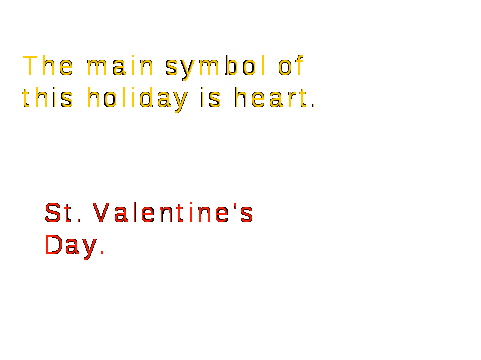
Слайд 2
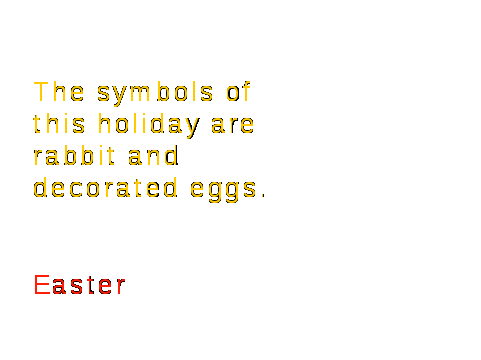
Слайд 3

Слайд 4
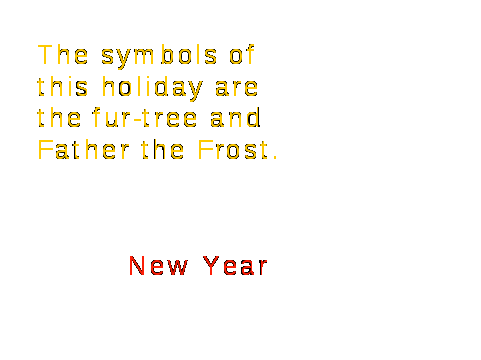
Слайд 5
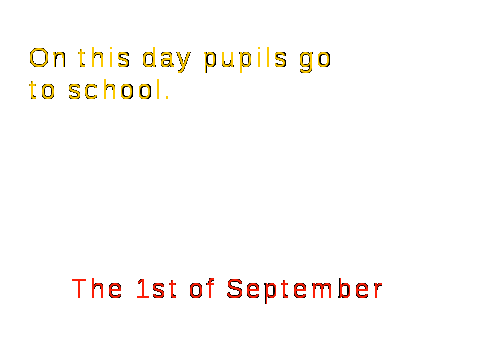
Слайд 6

Слайд 7
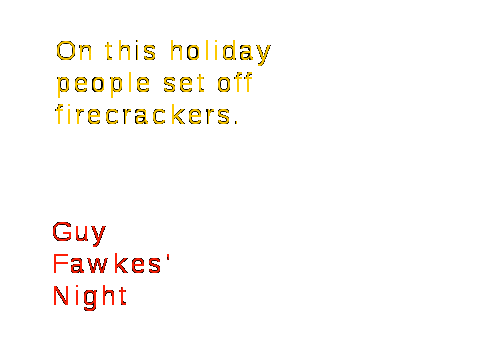
Слайд 8
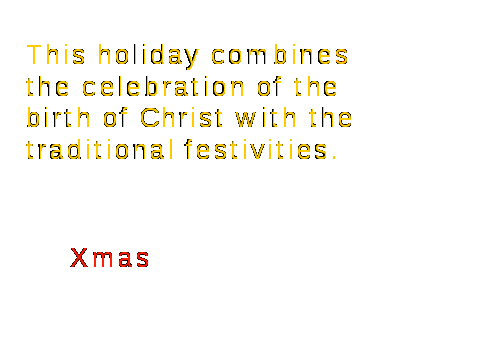
Слайд 9

Слайд 10
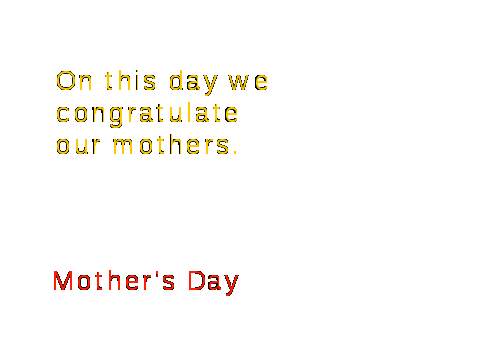
Слайд 11
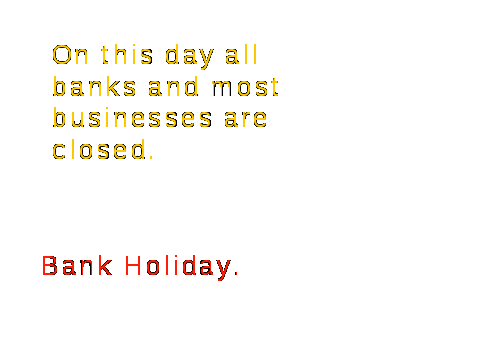
Приложение 4
Bank Holiday
Easter
St. Valentine's Day
New Year
The 1st of September
Xmas
Halloween
Mother's Day
Chinese New Year
Guy Fawkes' Night
Приложение 5

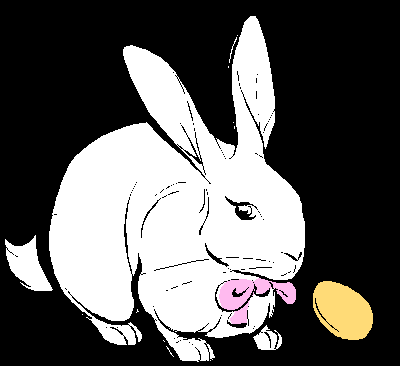
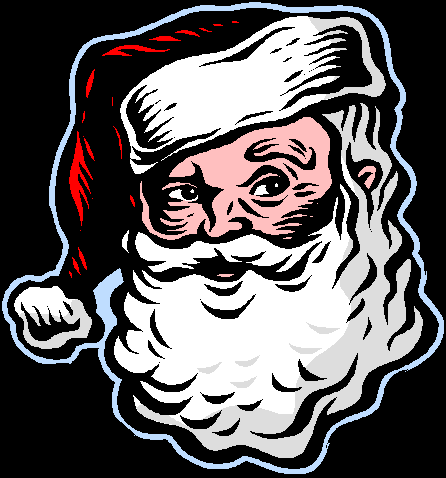

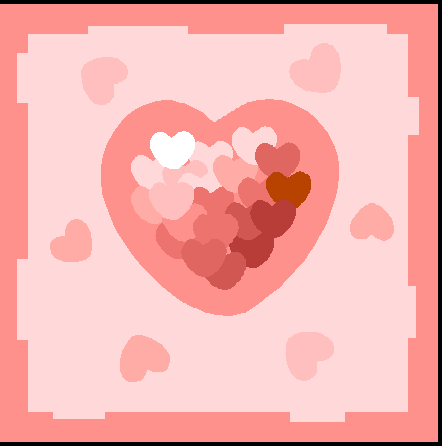
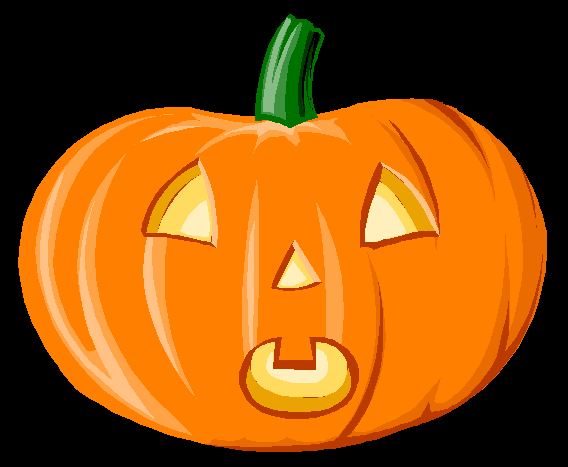
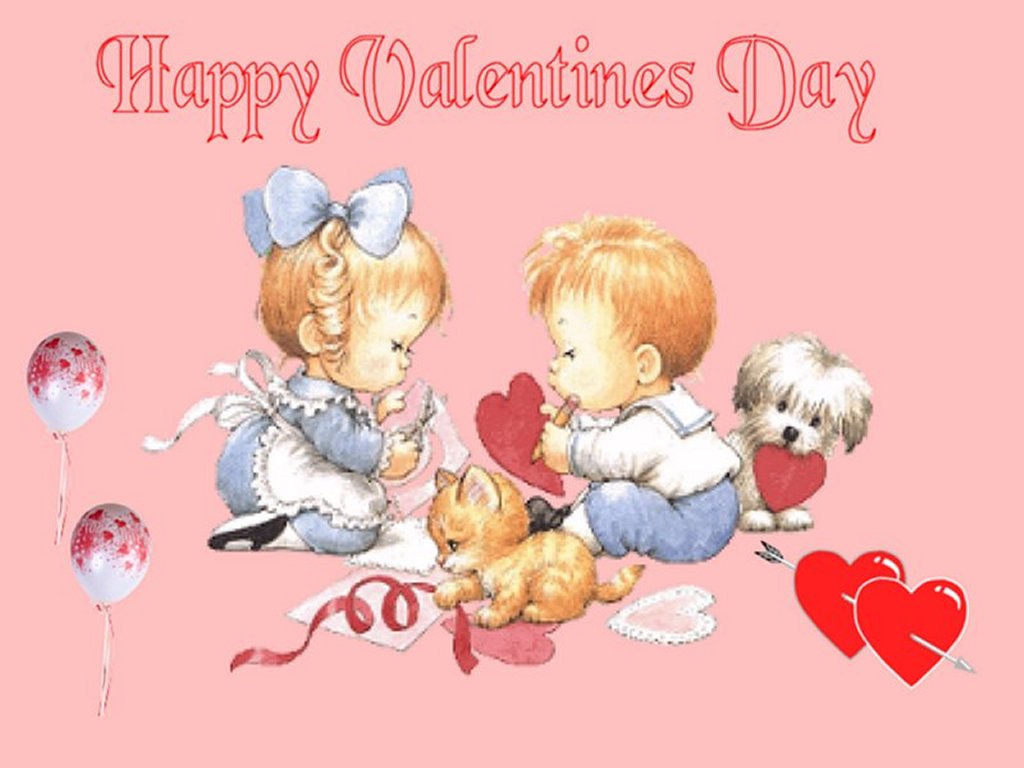

Приложение 6
Презентация № 3
Слайд 1
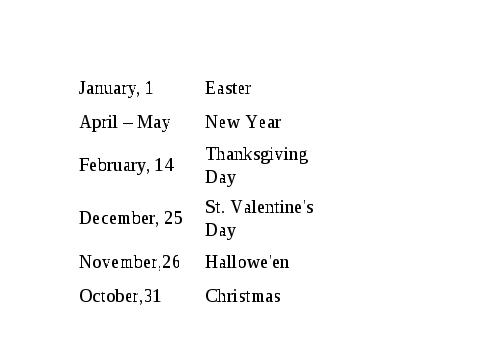
Слайд 2



